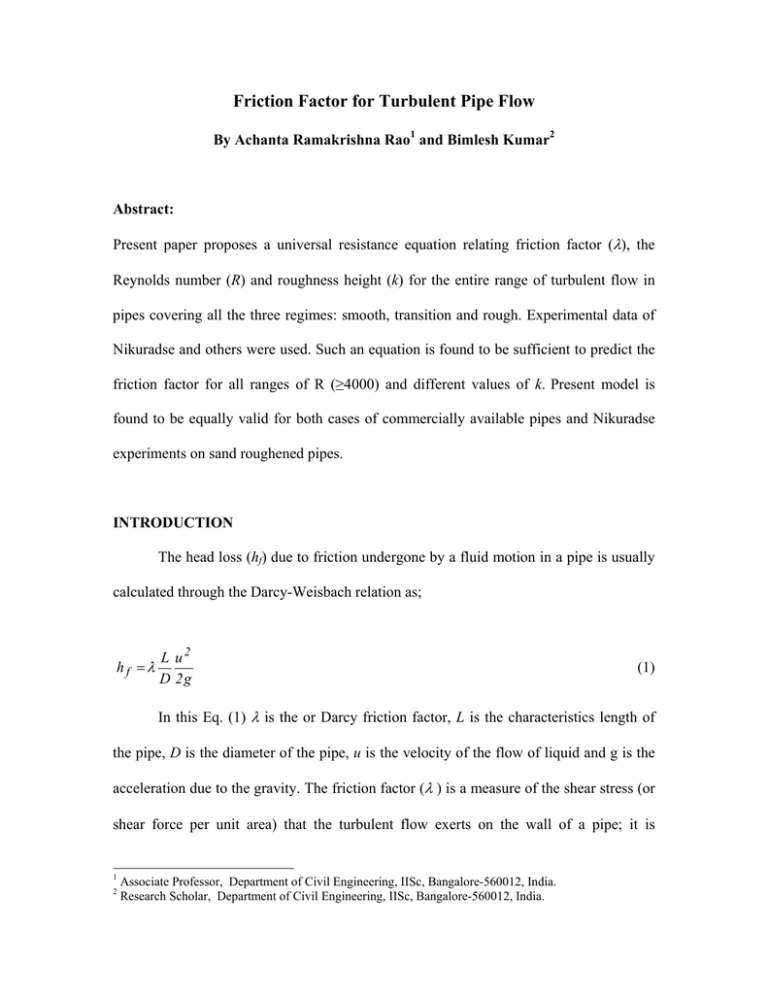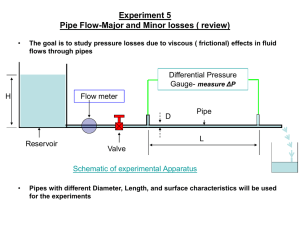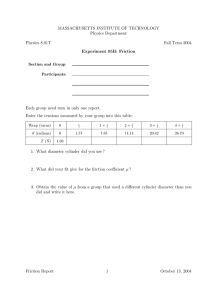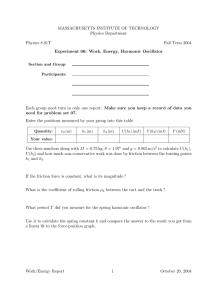Friction Factor for Turbulent Pipe Flow λ
advertisement

Friction Factor for Turbulent Pipe Flow By Achanta Ramakrishna Rao1 and Bimlesh Kumar2 Abstract: Present paper proposes a universal resistance equation relating friction factor (λ), the Reynolds number (R) and roughness height (k) for the entire range of turbulent flow in pipes covering all the three regimes: smooth, transition and rough. Experimental data of Nikuradse and others were used. Such an equation is found to be sufficient to predict the friction factor for all ranges of R (≥4000) and different values of k. Present model is found to be equally valid for both cases of commercially available pipes and Nikuradse experiments on sand roughened pipes. INTRODUCTION The head loss (hf) due to friction undergone by a fluid motion in a pipe is usually calculated through the Darcy-Weisbach relation as; hf =λ L u2 D 2g (1) In this Eq. (1) λ is the or Darcy friction factor, L is the characteristics length of the pipe, D is the diameter of the pipe, u is the velocity of the flow of liquid and g is the acceleration due to the gravity. The friction factor (λ ) is a measure of the shear stress (or shear force per unit area) that the turbulent flow exerts on the wall of a pipe; it is 1 2 Associate Professor, Department of Civil Engineering, IISc, Bangalore-560012, India. Research Scholar, Department of Civil Engineering, IISc, Bangalore-560012, India. customarily expressed in dimensionless form as λ = τ/ρū2, where, τ is the shear stress, ρ is the density of the liquid that flows in the pipe and ū the mean velocity of the flow. For laminar flow (Reynolds number, R ≤ 2100), the friction factor is linearly dependent on R, and calculated from the well-known Hagen-Poiseuille equation: λ= 64 R (2) Where, R, the Reynolds number, is defined as ūD/ν. Whereas, in turbulent flow (R≥ 4000), the friction factor, λ depends upon the Reynolds number (R) and on the relative roughness of the pipe, k/D, where, k is the average roughness height of the pipe. The general behavior of turbulent pipe flow in the presence of surface roughness is well established. When k is very small compared to the pipe diameter D i.e. k/D→0, λ depends only on R. When k/D is of a significant value, at low R, the flow can be considered as in smooth regime (there is no effect of roughness). As R increases, the flow becomes transitionally rough, called as transition regime in which the friction factor rises above the smooth value and is a function of both k and R and as R increases more and more, the flow eventually reaches a fully rough regime in which λ is independent of R. In a smooth pipe flow, the viscous sub layer completely submerges the effect of k on the flow. In this case, the friction factor λ is a function of R and is independent of the effect of k on the flow. Nikuradse (1933) had verified the Prandtl’s mixing length theory and proposed the following universal resistance equation for fully developed turbulent flow in smooth pipe; 1 λ ( ) = 2 log R λ − 0.8 (3) In case of rough pipe flow, the viscous sub layer thickness is very small when compared to roughness height and thus the flow is dominated by the roughness of the pipe wall and λ is the function only of k/D and is independent of R. The following form of the equation is first derived by Von Karman (Schlichting, 1979) and later supported by Nikuradse’s experiments; ⎛D⎞ = 2 log ⎜ ⎟ + 1.74 λ ⎝k⎠ 1 (4) For transition regime in which the friction factor varies with both R and k/D, the equation universally adopted is due to Colebrook and White (1937) proposed the following equation; ⎛ k D 2.5226 ⎞ = − 2 log ⎜⎜ + ⎟⎟ λ ⎝ 3.7065 R λ ⎠ 1 (5) Equation (5) covers not only the transition region but also the fully developed smooth and rough pipes. By putting k→ 0, Eq. (5) reduces to Eq. (3) for smooth pipes and as R→∞; Eq. (5) becomes Eq. (4) for rough pipes. Moody (1944) presented a friction diagram for commercial pipe friction factors based on the Colebrook–White equation, which has been extensively used for practical applications. Because of Moody’s work and the demonstrated applicability of Colebrook-White equation over a wide range of Reynolds numbers and relative roughness value k/D, Eq. (5) has become the accepted standard for calculating the friction factors. It suffers; however, from being an implicit equation in λ and thus requires an iterative solution. The U.S. Bureau of Reclamation (1965) reported large amounts of field data on commercial pipes: concrete, continuous-interior, girthriveted, and full-riveted steel pipes. Due to large variations in the field data, average friction factors were used for simplicity. The researchers of the Bureau of Reclamation (1965) found that some of the field data collected could not be explained by the Colebrook–White equation, since the variation of the data followed the curve of transitional turbulent flow which is omitted in the composition of the Colebrook–White equation. The Bureau of Reclamation report (1965) asserted that the Colebrook–White equation was found inadequate over a wide range of flow conditions. Moreover, several researchers have found that the Colebrook–White equation is inadequate for pipes smaller than 2.5 mm. Wesseling and Homma (1967) suggested using a Blasius-type equation or a power law with minor modifications instead of the Colebrook–White equation. They recommended using larger values of the proportionality factor for smaller-size pipes. Since the mid-1970s, many alternative explicit equations have been developed to avoid the iterative process inherent to the Colebrook- White equation. These equations give a reasonable approximation; however, they tend to be less universally accepted. Von Bernuth and Wilson (1989) conducted laboratory experiments and attempted to find the optimum value of the roughness height of PVC pipes for the Colebrook–White equation and then the value of the friction factor of PVC pipes. Their computation results were, however, quite different from those obtained in the laboratory when using the Colebrook–White equation. Instead they proposed to employ a Blasiustype equation with minor modifications. The friction factor determined from laboratory data decreases with an increase in the Reynolds number even after a certain critical value, whereas the friction factor of the Colebrook–White equation tends to be constant with an increase in the Reynolds number. Zagarola (1996) has indicated that the Prandtl’s law of flow in smooth pipes was not accurate for high Reynolds numbers and the ColebrookWhite correlation (which was based on the Prandtl’s law of flow) is not accurate at high Reynolds numbers. Motivation has thus existed for attempting to develop a universal resistance equation covering the entire ranges of turbulent flows, i.e., smooth to rough turbulent flows, which can be applicable to all the ranges of R and for all values of k/D. PROPOSED MODEL The established laws of velocity distribution for turbulent flows are given by, yu ν u = A ln * u* a y k u = A ln b u* For smooth pipes and (6) For rough pipes (7) Where ‘A’, ‘a’ and ‘b’ are constants, u is the velocity at a distance y measured from the pipe wall, u* is the friction velocity, k is the roughness height and n is the kinematic viscosity of the fluid. As seen from the Eqs. 6 and 7, the characteristic length l for non-dimensionalising the depth y is ν/u* for smooth turbulent flows and k for rough turbulent flows. So it is proposed that l is actually a linear combination of both (ν/u* and k) with a correction factor, covering the all ranges i.e., smooth, transition and rough regimes of turbulent flows. Thus l =( a ν u* + bk )φ ( R* ) (8) Where, R* is the friction Reynolds number and defined equal to ku*/ν. At R*→0, pipe is said to be in smooth condition and for rough pipe R*→∞. For large values of ν/u* the term aν/u* dominates making the second term bk negligible in comparison with it. So also for small values of ν/u*, the second term becomes important allowing the neglect of the first term. Thus the velocity laws covering all the regions can be summarized as, u = A ln u* y (a ν u* y k ⇒ A ln + bk )φ ( R* ) ( a + b )φ ( R* ) R* (9) Now, if a condition that φ ( R* ) =1 for both when R*→0 and ∞ is imposed, Eq. 9 reduces to Eqs. 6 and 7 respectively. From the relation λ = 8(u*/ū) 2, Eq. 9 can be converted into the equation for the friction factor covering the whole ranges of turbulent flows. Thus the resistance equation for pipes covering the smooth, transition and rough regimes can be expressed as, ⎛r k⎞ ⎟⎟ = 2 log ⎜⎜ λ ⎝ B* ⎠ 1 (10) ⎡ a + bR* ⎤ Where, B* = ⎢ ⎥Φ ( R* ) ⎣ R* ⎦ (11) By analyzing Nikuradse’s data on pressure drop measurements in sand roughened pipes, the following values of a = 0.444 and b= 0.135 has been found and Φ(R*) is given by, φ ( R* ⎡ ⎛ R ⎞⎤ − 0.33 ⎢ln⎜ * ⎟ ⎥ ⎣ ⎝ 6.5 ⎠ ⎦ ) = 1 − 0.55e 2 (12) The validity of the expression for B* along with φ(R*) is shown in Figure 1 by using the Nikuradse’s experimental data. 10 Nikuradse's Experimental data r / k =507 r / k =252 r / k =126 r / k =60 r / k =30.6 r / k =15 ) R* φ( 1 B* 0.1 0.01 0.1 1 10 100 1000 R* Figure 1: Validation of the proposed model 10000 The friction diagram based on Nikuradse’s experimental data on the sand roughened pipe is shown in Figure 2. Nikuradse's Experimental data r / k =507 r / k =252 r / k =126 r / k =60 r / k =30.6 r / k =15 McKeon et al., 2004 0.065 r / k =15.0 0.060 0.055 0.050 30.6 0.045 λ 0.040 60 0.035 0.030 126 0.025 252 507 0.020 0.015 Turbulent Flow 0.010 3 10 4 5 10 10 6 10 R Figure 2: Friction factor diagram The resistance equation, as given by Eq. 10 satisfactorily fits the entire data of Nikuradse on sand roughened pipes for varying relative roughness heights. In addition to Nikuradse’s experimental data, resistance equation is also plotted for the most recent experimental pipe friction data on smooth pipes (McKeon et al, 2004). Thus a universal resistance equation is developed in the form of Eq. (10). REVIEW OF EQUATIONS ON FRICTION FACTOR During the past years since Moody’s chart, the most promising equations on friction factor have appeared as follows: 1. Wood (1966): It is valid for R > 10000 and 10-5 < ε/D< 0.04. λ = a + b R −c (13) Where a = 0.53(k/D) +0.094 (k/D) 0.225, b = 88(k/D) 0.44 and C =1.62(k/D) 0.134. 2. Swamee and Jain (1976): They proposed the equation covering the range of R from 5000 to 107 and the values of k/D between 0.00004 and 0.05 as: λ= 0.25 ⎡ ⎛ k 5.74 ⎞⎤ ⎢log ⎜⎜ + 0.9 ⎟⎟⎥ ⎣ ⎝ D R ⎠⎦ (14) 2 3. Churchill (1977): The author claimed that his equation holds for all R and k/D and has the following form: ⎛ ⎛ 8 ⎞12 λ = 8⎜ ⎜ ⎟ + ( A + B )− 3 ⎜⎝ R ⎠ ⎝ ⎞ 1 12 2⎟ ⎟ ⎠ (15) Where A = [-2log(((k/D)/3.7)+(7/R)0.9)]16 and B = (37530/R)16. 4. Chen (1979): He also proposed equation for friction factor covering all the ranges of R and k/D. ⎡ ⎛ 1 ⎛ k ⎞1.1098 5.8506 ⎞⎤ k 5.0452 ⎟⎥ log ⎜ = − 2 log ⎢ − + ⎜ ⎟ 0 . 8981 ⎟⎥ ⎜ 3 . 7065 D R 2 . 8257 D ⎢ λ ⎝ ⎠ R ⎠⎦ ⎝ ⎣ 1 (16) 5. Round (1980): He proposed the equation in the following form: k 6.5 ⎞ ⎛ = − 1.8 log ⎜ 0.27 + ⎟ D R ⎠ λ ⎝ 1 (17) 6. Barr (1981): He proposed the equation as: ⎛ ⎜ ⎜ 1 k = − 2 log ⎜ + ⎜ 3.7 D λ ⎜ ⎜ ⎝ ⎞ ⎟ ⎟ ⎟ 0.7 ⎞ ⎟ ⎛ 1 0.52 ⎛ k ⎞ ⎟ ⎟ R R⎜ 1 + ⎜ ⎟ ⎜ 29 ⎝ D ⎠ ⎟⎠ ⎟⎠ ⎝ ⎛1 ⎞ 4.518 log ⎜ R ⎟ ⎝7 ⎠ (18) 7. Zigrang and Sylvester (1982): They proposed the following equation: ⎡ k ⎛ 1 ⎛ k ⎞ 5.02 13 ⎞ ⎞⎤ 5.02 ⎛ k + ⎟ ⎟⎟⎥ = − 2 log ⎢ − log ⎜⎜ log ⎜ ⎜ ⎟− R R λ ⎝ 3.7 D R ⎠ ⎠⎦ ⎝ 3.7 ⎝ D ⎠ ⎣ 3.7 D 1 (19) 8. Haaland (1983): He proposed a variation in the effect of the relative roughness by the following expression: ⎡⎛ k ⎞1.11 6.9 ⎤ ⎥ + = − 1.8 log ⎢⎜ ⎟ R⎥ λ ⎢⎣⎝ 3.7 D ⎠ ⎦ 1 (20) 9. Manadilli (1997): He proposed the following expressions valid for R ranging from 5235 to 108 and for any value of k/D. ⎛ k 95 96.82 ⎞ ⎟ = − 2 log ⎜⎜ + − 0 . 983 R ⎟⎠ λ ⎝ 3.7 D R 1 (21) 10. Romeo et al. (2002): They proposed the equation as: k 5.0272 ⎤ ⎡ = − 2 log ⎢ − A⎥ R λ ⎣ 3.7065 D ⎦ 1 (22) ⎛ k ⎛ ⎛ k D ⎞ 0.9924 ⎛ 5.3326 ⎞ 0.9345 ⎞ ⎞ 4.567 ⎜ ⎟⎟ Where, A = log log ⎜ ⎜ − +⎜ ⎟ ⎟ ⎜ 3.827 D ⎜ ⎟⎟ 7.7918 ⎠ R ⎝ 208.815 + R ⎠ ⎝⎝ ⎠⎠ ⎝ DISCUSSIONS The correlations/friction factor relations shown in the literature have been developed by applying the successive substitution method to the Colebrook-White formula. More accuracy can be achieved by using a large number of internal substitutions to the Colebrook-White formula, thus a new explicit formula for calculating the friction factor. As discussed, Colebrook-White formula deviates from Nikuradse experimental results in transition range, because of their difference in roughness factor. Colebrook –White formula is for irregular surface roughness in pipes resulting from the manufacturing process. Present model is equally valid for commercial pipes and sand roughened pipes. By making correction factor φ(R*) =1, comparison are made for prediction of λ over a wide range of k/D by Eq. (10) and Colebrook-white formula. As shown in Figure 3, present model predicts approximately the same λ as predicted by Colebrook-white formula. Figure 4 gives the percentage error in prediction of the friction factor by the present model. As shown, the error ranges from -0.12292 to 0.04884%, making the present model acceptable for commercial pipes. 0.11 PM PM PM PM k/D =0.05 0.10 0.09 0.08 λ 0.07 CW CW CW CW k/D = 0.00005 k/D = 0.0005 k/D = 0.005 k/D = 0.05 0.06 0.05 0.04 k/D =0.005 0.03 k/D =0.0005 k/D =0.00005 0.02 0.01 10000 100000 1000000 1E7 1E8 R Figure 3 Prediction for commercial pipe (PM –present model, CW-Colebrook-White formula) 0.08 Average % Error line m m Max = 0.04884 and Min = -0.12292 0.06 100 (λCW-λPM) -----------------λPM 0.04 0.02 0.00 -0.02 -0.04 -0.06 -0.08 -0.10 -0.12 -0.14 1000000 1E7 1E8 R Figure 4 Percentage of error in the estimation of λ with Colebrook-White formula APPLICATION OF THE PROPOSED MODEL Estimation of head losses due to friction in pipes is an important task in optimization studies and hydraulic analysis of pipelines and water distribution systems. It is vital in new pipeline design to have a good estimate of flow capacity as the larger part of the economics will be dependent on this. In most cases, hydraulic engineers use the HazenWilliams formula (V=0.849 C Rh0.63 S0.54, where, C is the Hazen-Williams constant, Rh is the hydraulic radius of the pipe and S is the slope) to characterize the roughness of the pipe’s inner surface. However, being empirical, the Hazen-Williams equation is not dimensionally homogeneous and its ranges of applicability is limited (Liou, 1998). By making use of Eq. (1), Eq. (5) and Hazen-Williams formula, C can be interpreted as C = 14.07 λ-0.54 R0.06 (k/D)0.01 k-0.01 ν0.08, is implying that C is a function of R, k/D, k, and kinematic viscosity, ν. C is also found to be dependent on pipe diameter (Liou, 1998). 200 Roughness Height, k 7.1 microns 23.1 microns 190 = λ, friction factor = U m/s, average velocity 3 = Q m /s, discharge = hf /L, hydraulic gradient Hazen-Williams, C 180 170 -6 2 Note: Kinematic Viscosity is assumed as, ν = 10 m /s 160 150 140 130 120 -8 10 -7 10 -6 10 -5 1x10 -4 1x10 -3 10 -2 10 -1 10 0 10 1 10 2 10 Hydraulic Parameter (friction factor, average velocity, discharge and hydraulic gradient) Relationship Between Hazen Williams C and Hydraulic Parameters Figure 4 Variations in C 3 10 IS-SP35:1987 (Handbook on water supply and Drainage with Special Emphasis on Plumbing) gives the values of Hazen-Williams constant ‘C’ in some ranges for different types of pipe materials, i.e., for cast iron new pipe, the recommended value of C is 130 and for design purpose, it is 130. As shown in Figure 4, assuming C as constant is hazardous. As discussed, proposed model predicts reasonably well in the entire turbulent ranges of pipe flow and equally valid in case of commercial pipes as well as sand roughened pipes, this can be used as an alternative of Hazen-Williams formula in designing the pipeline. CONCLUSION Based on the Nikuradse’s experimental data, an improved version of equation on friction factor covering the whole turbulent flow range flow has been presented. Reference: 1. Barr, D.I.H., “Solutions of the Colebrook-White functions for resistance to uniform turbulent flows.”, Proc. Inst. Civil. Engrs. Part 2. 71,1981. 2. Chen, N.H., “An Explicit Equation for Friction factor in Pipe”, Ind. Eng. Chem. Fundam., Vol. 18, No. 3, 296-297, 1979. 3. Churchill, S.W., “Friction factor equations spans all fluid-flow ranges.”, Chem. Eng., 91,1977. 4. Colebrook, C.F. and White, C.M., “Experiments with Fluid friction roughened pipes.”,Proc. R.Soc.(A), 161,1937. 5. Haaland, S.E., “Simple and Explicit formulas for friction factor in turbulent pipe flow.”, Trans. ASME, JFE, 105, 1983. 6. Liou, C.P., “Limiations and proper use of the Hazen-Williams equations.”, J. Hydr., Eng., 124(9), 951-954, 1998. 7. Manadilli, G., “Replace implicit equations with sigmoidal functions.”, Chem.Eng. Journal, 104(8), 1997. 8. McKeon, B.J., Swanson, C.J., Zagarola, M.V., Donnelly, R.J. and Smits, A.J., “Friction factors for smooth pipe flow.”, J.Fluid Mechanics, Vol.541, 41-44, 2004. 9. Moody, L.F., “Friction factors for pipe flows.”, Trans. ASME, 66,641,1944. 10. Nikuradse, J. “Stroemungsgesetze in rauhen Rohren.” Ver. Dtsch. Ing. Forsch., 361, 1933. 11. Romeo, E., Royo, C., and Monzon, A., ‘‘Improved explicit equations for estimation of the friction factor in rough and smooth pipes.’’ Chem. Eng. J., 86, 369–374, 2002. 12. Round, G.F., “An explicit approximation for the friction factor-Reynolds number relation for rough and smooth pipes.”, Can. J. Chem. Eng., 58,122-123,1980. 13. Schlichting, H., “Boundary-Layer Theory” ,McGraw–Hill, New York, 1979.. 14. Swamee, P.K. and Jain, A.K., “Explicit equation for pipe flow problems.”, J. Hydr. Div., ASCE, 102(5), 657-664, 1976. 15. U.S. Bureau of Reclamation., “Friction factors for large conduit flowing full.” Engineering Monograph, No. 7, U.S. Dept. of Interior, Washington, D.C, 1965. 16. Von Bernuth, R. D., and Wilson, T., “Friction factors for small diameter plastic pipes.” J. Hydraul. Eng., 115(2), 183–192, 1989. 17. Wesseling, J., and Homma, F., “Hydraulic resistance of drain pipes.” Neth. J. Agric. Sci., 15, 183–197, 1967. 18. Wood, D.J., “An Explicit friction factor relationship.”, Civil Eng., 60-61,1966. 19. Zagarola, M. V., ‘‘Mean-flow Scaling of Turbulent Pipe Flow,’’ Ph.D.thesis, Princeton University, USA, 1996. 20. Zigrang, D.J. and Sylvester, N.D., “Explicit approximations to the Colebrook’s friction factor.”, AICHE J. 28, 3, 514, 1982. NOTATION C = Hazen-Williams Constant; D = Pipe diameter; f = Friction factor; g = Acceleration due to gravity; hf = Head loss; k = Roughness height; L = Characteristics length of the pipe; u = Velocity of the flow; ū = Mean velocity of the flow; u* = Shear velocity; r = Pipe radius; R = Reynolds number; Rh = Hydraulic radius of the pipe; ν = Kinematic viscosity; τ = Shear stress; B* = Function of R*; R* = Particle Reynolds number.







